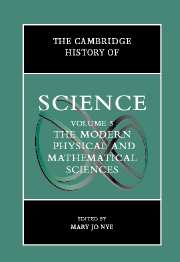Book contents
- Frontmatter
- Introduction: The Modern Physical and Mathematical Sciences
- Part I The Public Cultures of the Physical Sciences After 1800
- Part II Discipline Building in the Sciences: Places, Instruments, Communication
- Part III Chemistry and Physics: Problems Through the Early 1900s
- Part IV Atomic and Molecular Sciences in the Twentieth Century
- 17 Quantum Theory and Atomic Structure, 1900–1927
- 18 Radioactiviy and Nuclerar Physics
- 19 Quantum Field Theory: From QED to the Standard Model
- 20 Chemical Physics and Quantum Chemistry in the Twentieth Century
- 21 Plasmas and Solid-State Science
- 22 Macromolecules: Their Structures and Functions
- Part V Mathematics, Astronomy, and Cosmology Since the Eighteenth Century
- Part VI Problems and Promises at the End of the Twentieth Century
- Index
- References
17 - Quantum Theory and Atomic Structure, 1900–1927
from Part IV - Atomic and Molecular Sciences in the Twentieth Century
Published online by Cambridge University Press: 28 March 2008
- Frontmatter
- Introduction: The Modern Physical and Mathematical Sciences
- Part I The Public Cultures of the Physical Sciences After 1800
- Part II Discipline Building in the Sciences: Places, Instruments, Communication
- Part III Chemistry and Physics: Problems Through the Early 1900s
- Part IV Atomic and Molecular Sciences in the Twentieth Century
- 17 Quantum Theory and Atomic Structure, 1900–1927
- 18 Radioactiviy and Nuclerar Physics
- 19 Quantum Field Theory: From QED to the Standard Model
- 20 Chemical Physics and Quantum Chemistry in the Twentieth Century
- 21 Plasmas and Solid-State Science
- 22 Macromolecules: Their Structures and Functions
- Part V Mathematics, Astronomy, and Cosmology Since the Eighteenth Century
- Part VI Problems and Promises at the End of the Twentieth Century
- Index
- References
Summary
Quantum mechanics is a most intriguing theory, the empirical success of which is as great as its departure from the basic intuitions of previous theories. Its history has attracted much attention. In the 1960s, three leading contributors to this history, Thomas Kuhn, Paul Forman, and John Heilbron, put together the Archive for the History of Quantum Physics (AHQP), which contains manuscripts, correspondence, and interviews of early quantum physicists. In the same period, Martin Klein wrote clear and penetrating essays on Planck, Einstein, and early quantum theory; and Max Jammer published The Conceptual Development of Quantum Mechanics, still the best available synthesis.
Since then, this subfield of the history of science has grown considerably, as demonstrated in accounts such as the five-volume compilation by Jagdish Mehra and Helmut Rechenberg; the philosophically sensitive studies by Edward MacKinnon, John Hendry, and Sandro Petruccioli; Bruce Wheaton’s work on the empirical roots of wave-particle dualism; my own book on the classical analogy in the history of quantum theory; and a number of biographies.
These sources nicely complement one another. There have been, however, a couple of bitter controversies. Historians notoriously disagree about the nature of Planck’s quantum work around 1900. Whereas Klein sees in it a sharp departure from classical electrodynamics, Kuhn denies that Planck introduced any quantum discontinuity before Einstein. Here I take Kuhn’s side, although it follows from Allan Needell’s insightful dissertation that neither Klein nor Kuhn fully identified Planck’s goals.
- Type
- Chapter
- Information
- The Cambridge History of Science , pp. 329 - 349Publisher: Cambridge University PressPrint publication year: 2002



